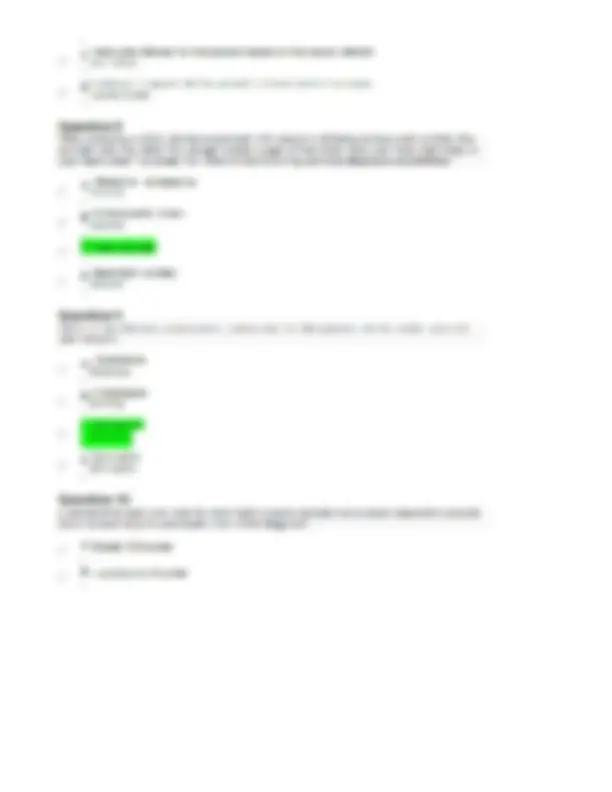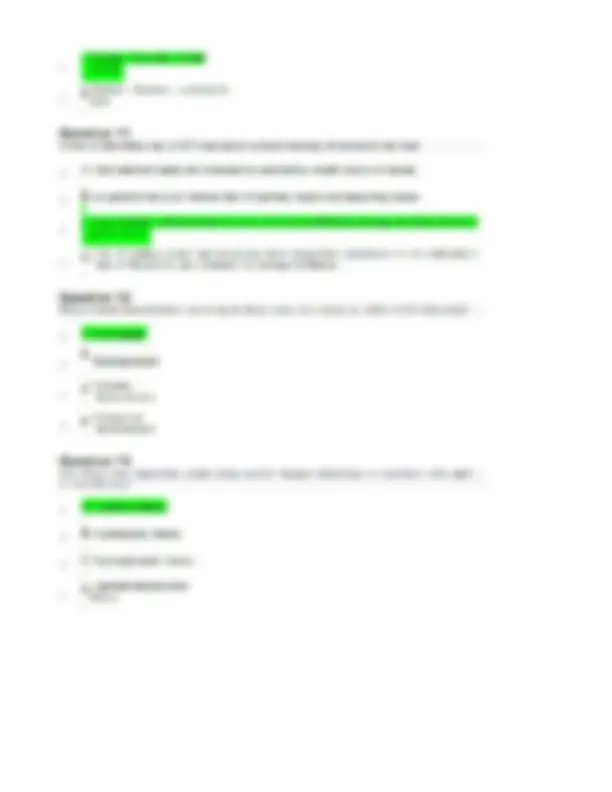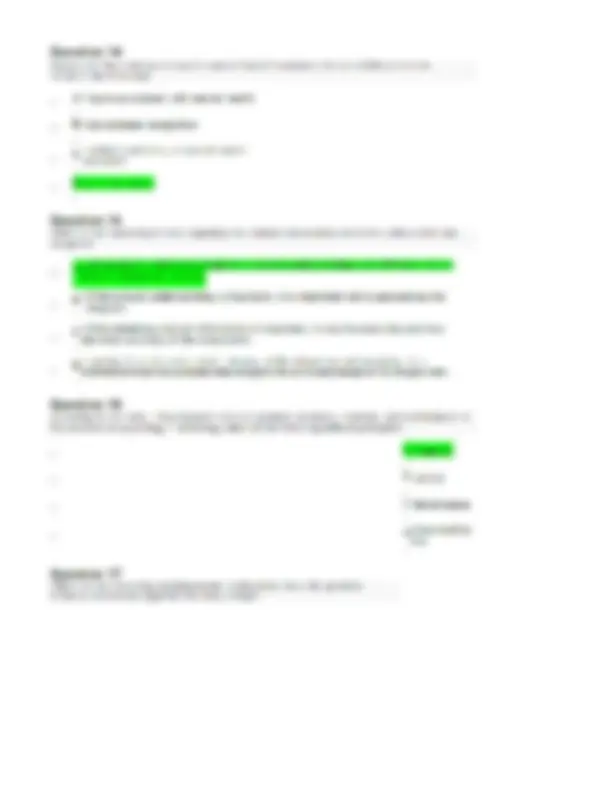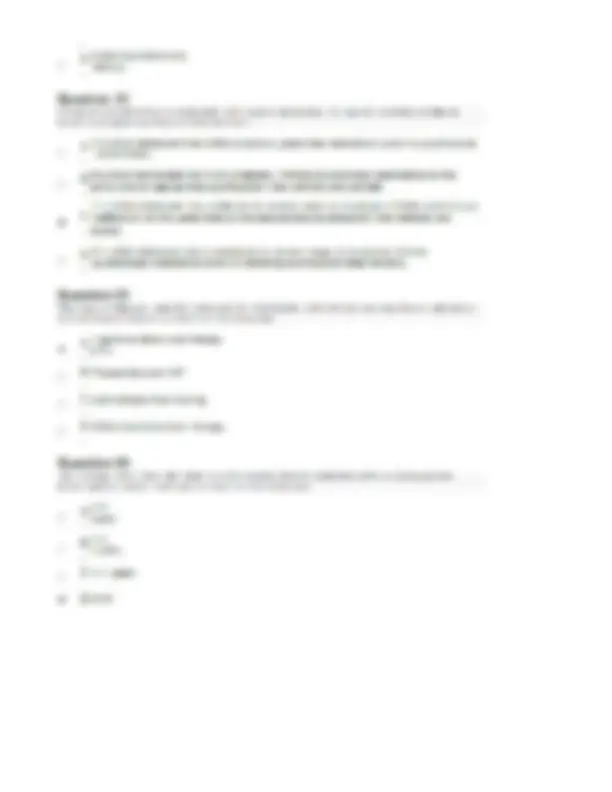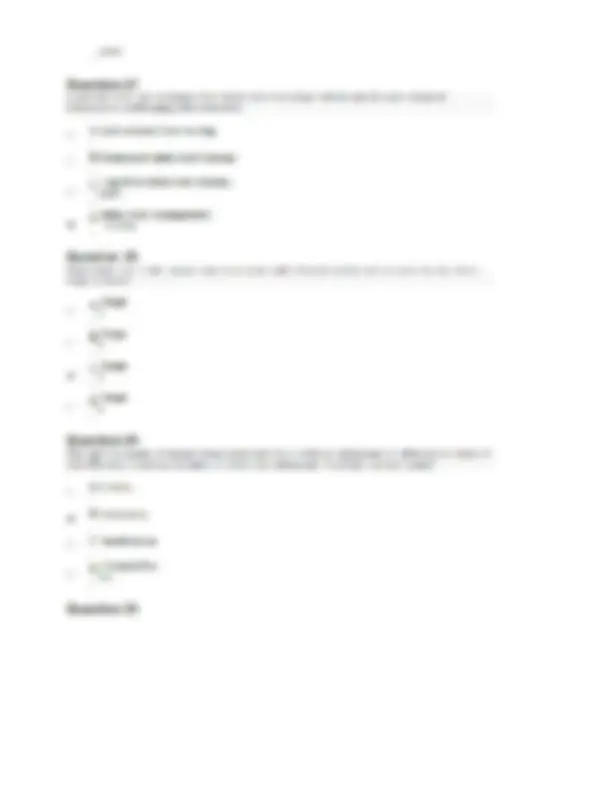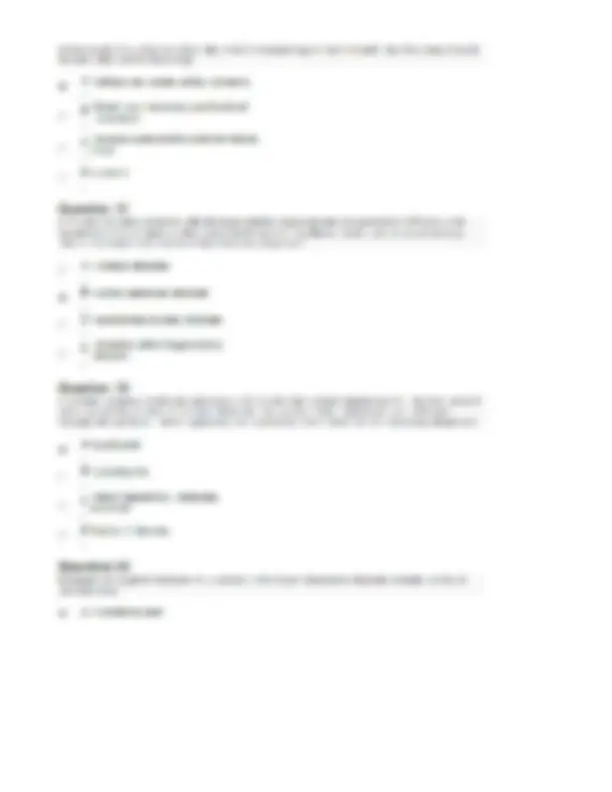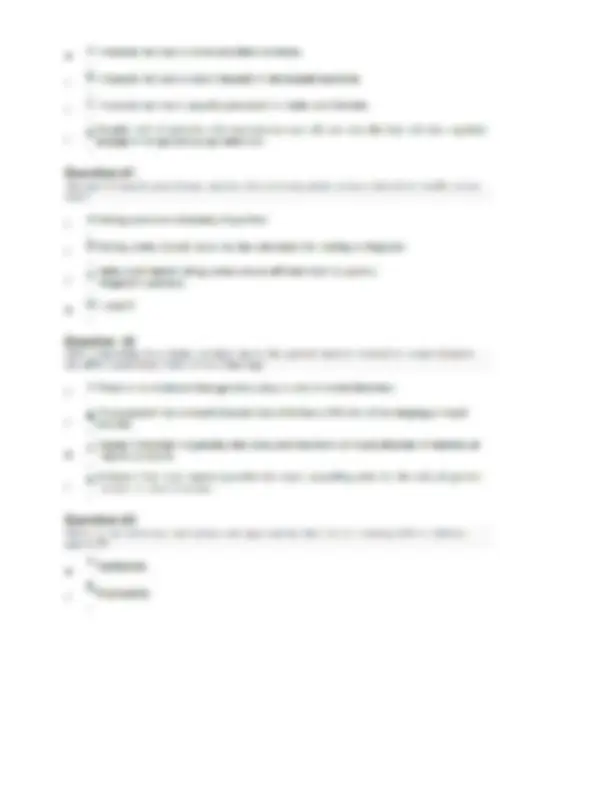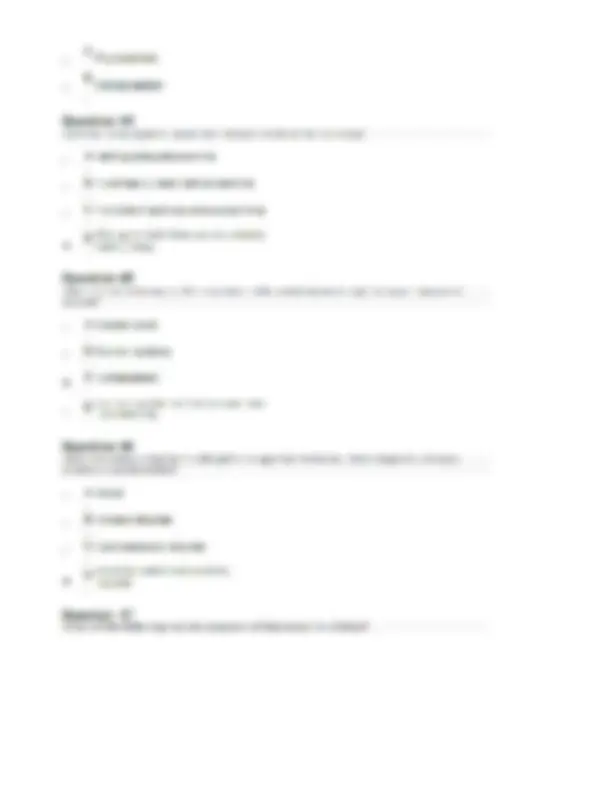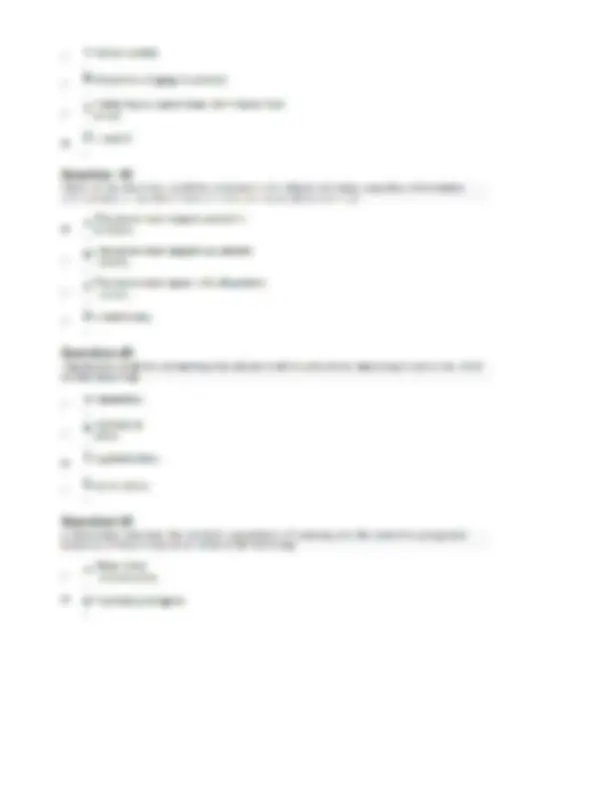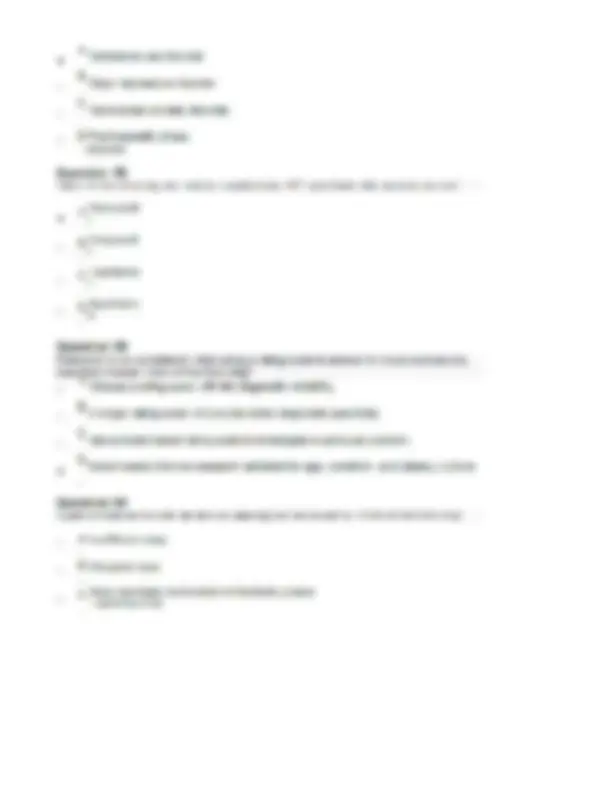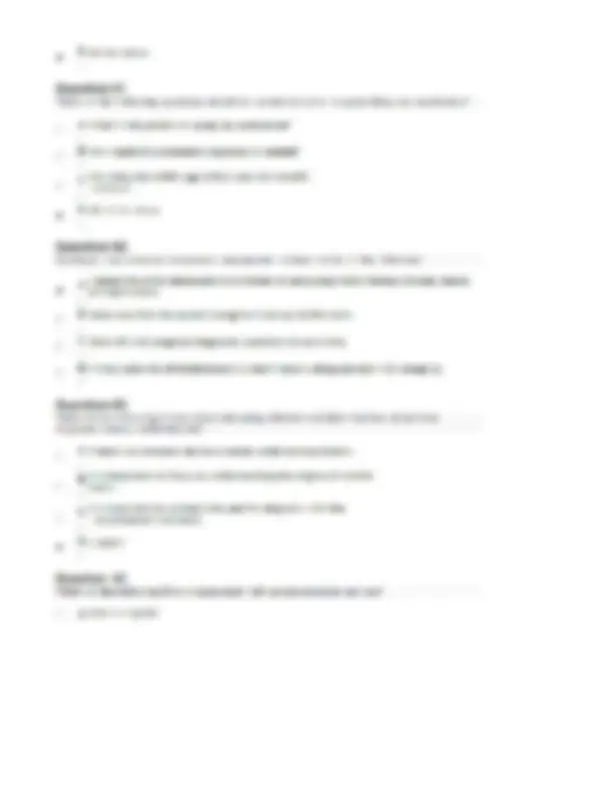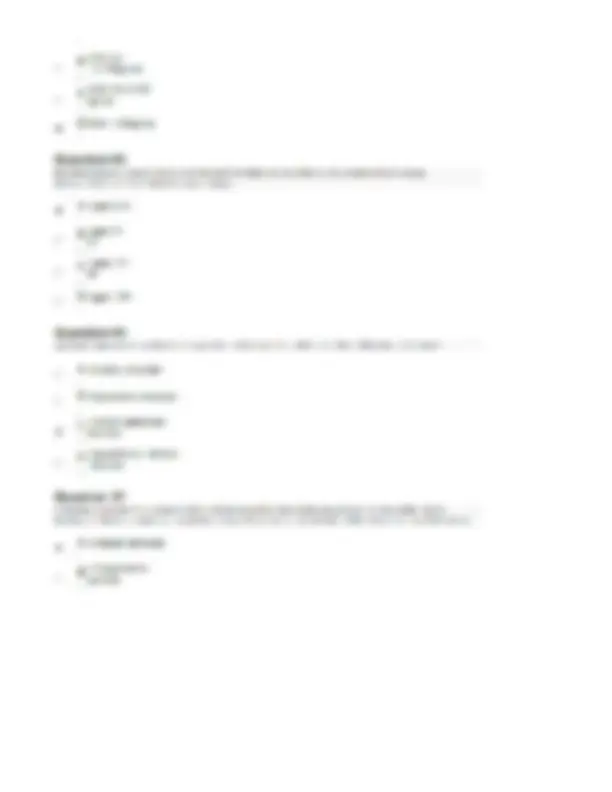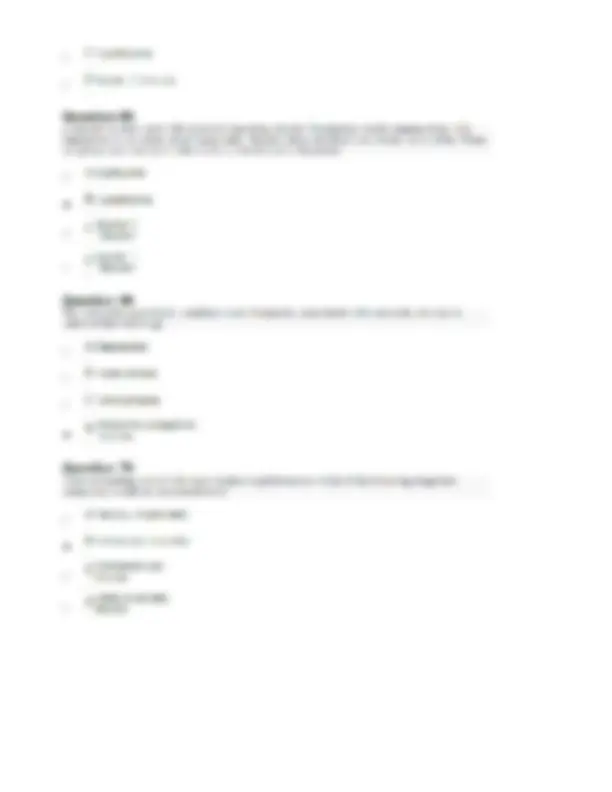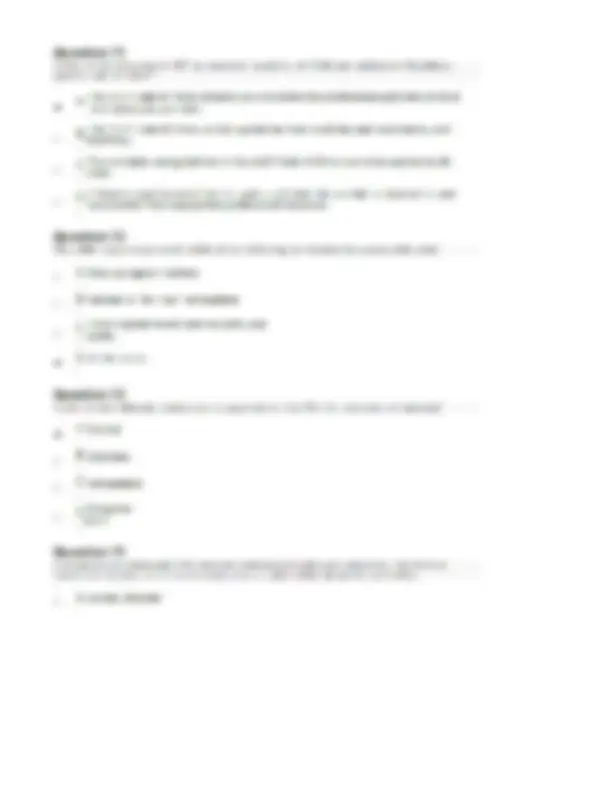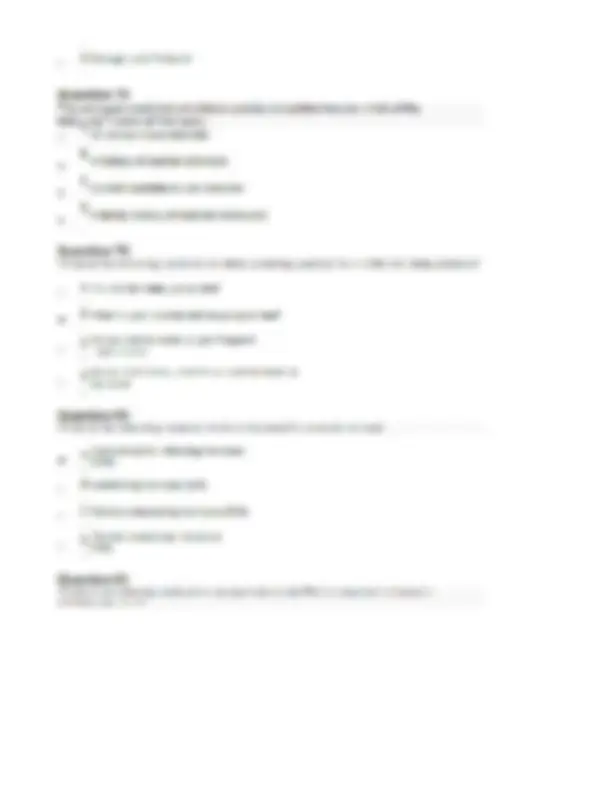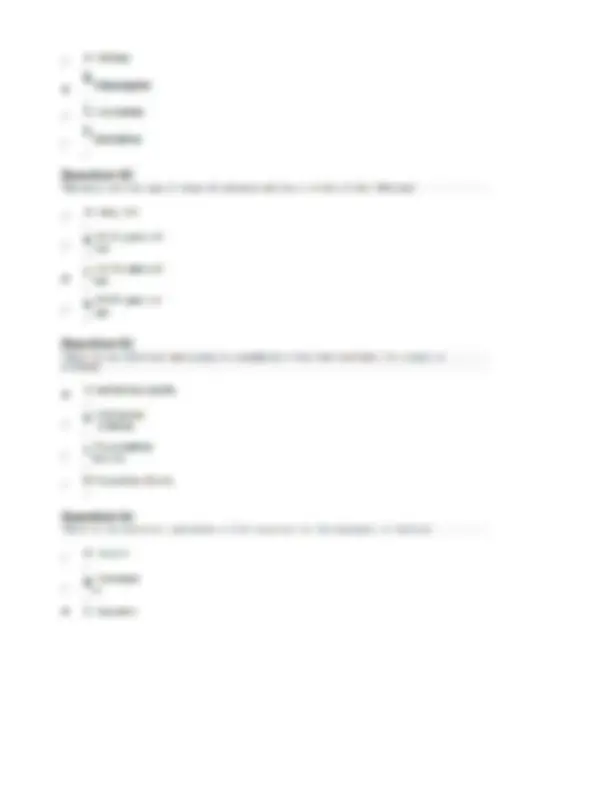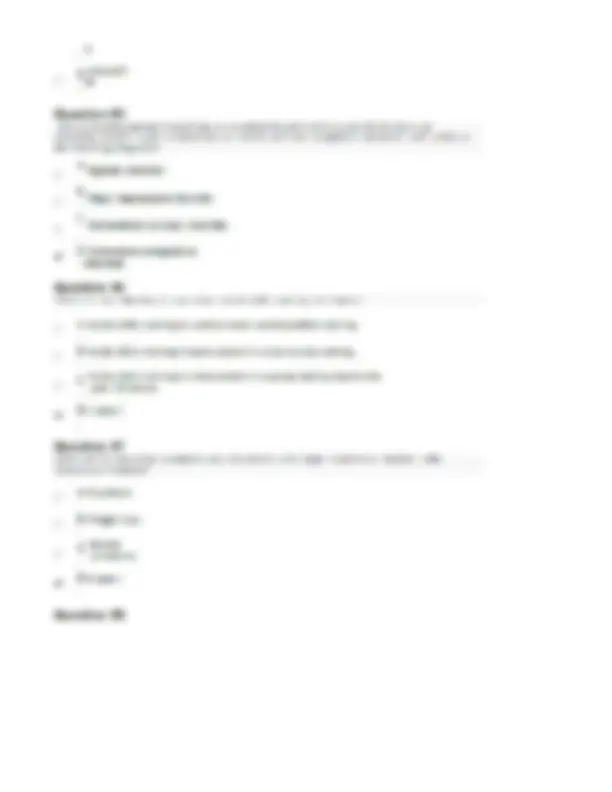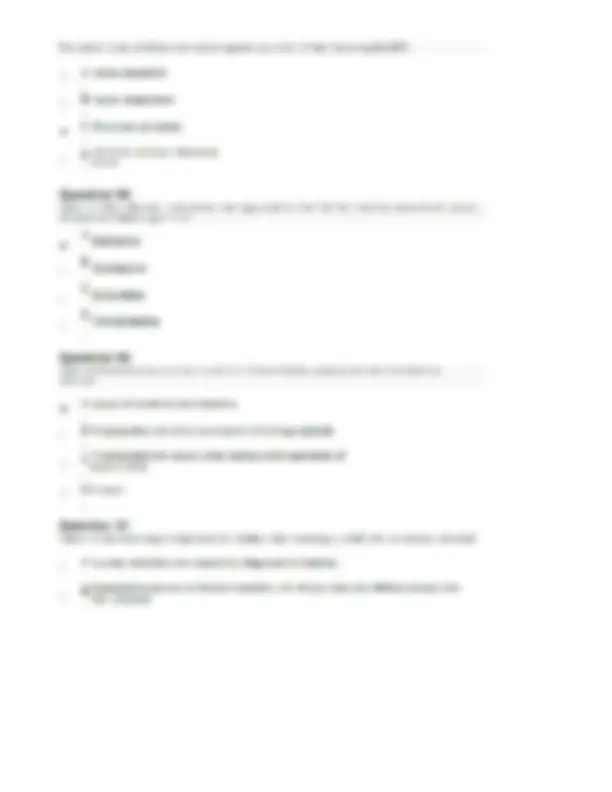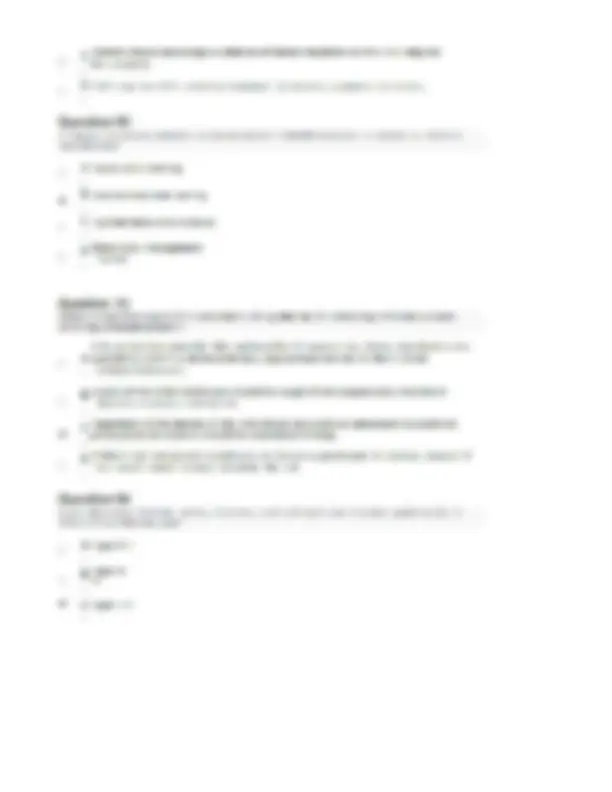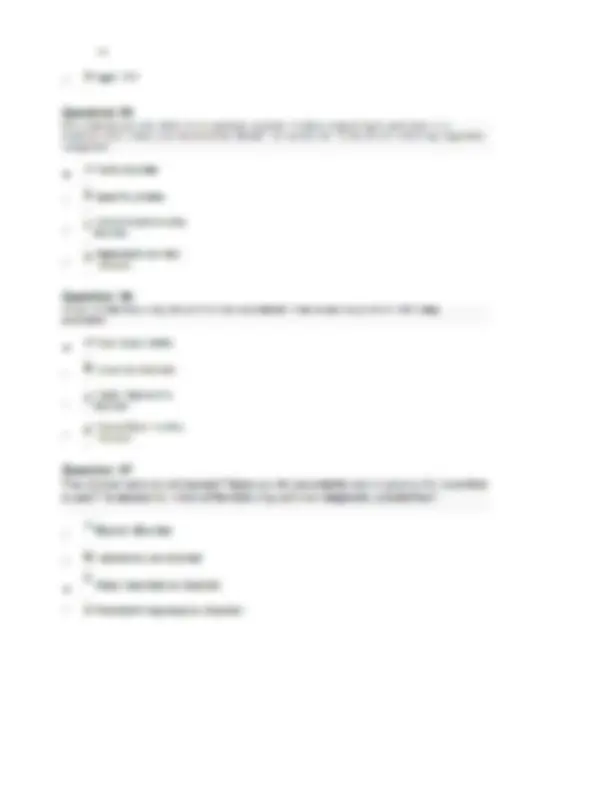Partial preview of the text
Download NRNP 6665 Midterm Exam (Latest-2025, 100 Q & A) / NRNP6665 Midterm Exam: Walden University and more Exams Nursing in PDF only on Docsity!
Question 1 Biofeedback, deep breathing, mindfulness, and progressive muscle relaxation are strategies that are typically used in which of the following therapies? _ A Relaxation therapy cB Social skills training C Motivational Cc Interviewing D Applied behavioral Cc analysis Question 2 According to the APA which of the following are required to support a child’s DSM- 5 diagnosis? The child’s clinical presentation fulfills the specific symptom based Cc diagnostic criteria. c B The child’s symptoms are not caused by other diagnoses or stressors. - Corin mPnons ave mpeteng lets cong nas ows ve c DA andB Question 3 Which of the following is HOT consistent with good sleep hygiene? = A Allow child to keep a cell phone at bedside, B Establish bedtime routines and maintain consistently. Cc Limit use of electronics in the evening i.e., television, c ‘computer, etc. D Set and maintain a bedtime that will allow for adequate Cc sleep. c Question 4 Which of the following antipsychotic medications have the greatest tendency to increase appetite and body weight? cA Aripiprazole (Abilify) Ziprasidone c (Geodon) c C Haloperidot (Haldol) c rena Question 5 When assessing a child with disruptive or aggressive behavior, the clinician asks “Have you been thinking about or planning to hurt anyone?” to screen for which of the following diagnostic categories? c A Safety cB Bullying - € Conduct disorder D Oppositional defiant c disorder Question 6 The clinician assessing substance abuse in an adolescent asks, “Did you develop more mood or anxiety problems after you started using?” to screen for which of the following diagnostic possibilities? A Substance use disorder c cB Substance withdrawal cc C Substance tolerance - Peocer en meet Question 7 When the patient lacks capacity to make a decision the nurse has the ethical responsibility to do which of the following? c A Become a surrogate decision maker for the patient. © _B Consult a formally-designated surrogate for patient choices. > D Bipolar | Disorder, cyclothymic c type Question 11 Which of the following is OT true about symptomatology of anorexia nervosa? c A Most aberrant behaviors directed toward losing weight occurs in secret. c B All patients have an intense fear of gaining weight and becoming obese. - © pute aces. nore panonava nave none ening wan ep faye D Fear of gaining weight and becoming obese frequently contributes to the individual’s lack of interest in and resistance to therapy/treatment. 5 Question 12 Sleep-related hallucinations occurring at sleep onset are known as which of the following? - Alypnagogic B . c Hypnopompic c Complex © hallucinations D Paranormal o hallucinations Question 13 The theory that depression results from specific thought distortions is consistent with which of the following? A Cognitive theory c B Psychosocial theory c C Psychodynamic theory D Learned helplessness C theory Question 14 Reasons for the underuse of specific mental health treatments during childhood include which of the following? c A Stigma associated with mental health c B Poor problem recognition Cc Limited availability of mental health c specialists _ Dall of the above Question 15 Which of the following is true regarding the cultural formulation interview with a child and caregiver? c * Stes Serpaute llaces el Sndersending an efter my to B While cultural understanding is important, it is important not to personalize the c diagnosis. Cc While obtaining cultural information is important, it may increase bias and thus Cc decrease accuracy of the assessment. D Engaging in a discussion about culture, while interesting and engaging, is a oC distraction from the problem that brought the child and caregiver to the provider. Question 16 According to the APA, “Psychologists seek to promote accuracy, honesty, and truthfulness in the practice of psychology,” reflecting which of the following ethical principles? c A Integrity c B Justice c C Beneficence D Nonmalefice c nee Question 17 Which of the following antidepressant medications have the greatest tendency to increase appetite and body weight? c C Major depressive disorder D Disruptive mood dysregulation Cc disorder Question 21 Which of the following disorders is characterized by episodic bouts of intake of excessive amounts of food but without purging or similar compensatory behavior? cA Bulimia nervosa - B Anorexia nervosa Cc Binge eating c disorder D Hight eating Cc syndrome Question 22 During the evaluation of a patient with a history of Bipolar | Disorder, who is manic, the patient states that she is actually the Queen of England and quite wealthy. This is an example of which of the following? c A Mood-congruent manic delusion B Mood-incongruent manic c delusion ¢ Mood-congruent manic Cc hallucination D Mood-incongruent manic « hallucination Question 23 A form of cognitive behavioral therapy (CBT) that requires attending skills groups in addition to individual therapy sessions are known as which of the following? A Group CBT cB Trauma-Focused CBT © C Motivational Interviewing « D Dialectical-behavioral ia therapy Question 24 Which of the following is consistent with recommendations for use of available evidence- based psychopharmacological interventions? A !f a child/adolescent has mild symptoms, prescribe medications prior to psychosocial oc Interventions. B If a child/adolescent has mild symptoms, initiate psychotropic medication at the c same time as appropriate psychosocial interventions are started. If a child/adolescent has moderate to severe range of symptoms initiate psychotropic « C medication at the same time as the appropriate psychosocial interventions are . Started. If a child/adolescent has a moderate to severe range of symptoms initiate o psychotropic medication prior to initiating psychosocial interventions. Question 25 The type of therapy typically indicated for individuals with chronic and significant suicidality and self-harm is known as which of the following? A Cognitive behavioral therapy w (CBT) B Trauma-focused CBT c C Motivational interviewing c D Dialectical-behavioral therapy Question 26 The average time from the start of child mental health symptoms until a young person enters mental health treatment is which of the following? Ate c weeks. B36 oe months c C 1-2 years @® Ds&10 In the event of a crisis in which the child is threatening to hurt himself, the first steps should include which of the following? « A Address any acute safety concerns B Obtain any necessary professional C assistance ¢ Develop a prevention plan for future c crises DaAandB Question 31 A 10-year-old child presents with developmentally inappropriate and persistent difficulty with inattention with symptoms which are interfering with academic goals and in social settings. This is consistent with which of the following diagnoses? cA Conduct disorder w@ 8 Autism spectrum disorder C Generalized anxiety disorder D Attention-deficit/hyperactivity disorder 4 Question 32 A patient presents endorsing persistent low-grade (sub-acute) depression for the last several years, uncertain of when it started, thinks he has always been depressed but still goes through the motions. These symptoms are consistent with which of the following diagnoses? « A Dysthymia cB Cyelothymia Cc Major Depression, subacute, Cc recurrent c D Bipolar II disorder Question 33 Examples of atypical features in a patient with Major Depressive Episode include which of the following? « A Overeating and oversleeping B Loss of appetite c c CInsomnia c D Sleep walking Question 34 Somnambulism is characterized by which of the following? A Waking from sleep/naps with vivid recall of intensely frightening dreams c c B A sleep-wake pattern out of synchrony with the desired sleep-wake schedule c © Excessive daytime sleepiness or sleep attacks D Repeated episodes of rising from bed and walking about for between several minutes « to a half hour during nocturnal sleep Question 35 A 15-year-old girl presents with symptoms that include restrictive eating and food avoidance, with a desire to avoid obesity, which persists despite negative consequences. This presentation is consistent with which of the following diagnoses? c « c c A Bulimia nervosa B Anorexia nervosa C Encopresis D Autism spectrum disorder Question 36 Which of the following antidepressants are approved by the FDA for treating depression in children ages 8-17? c « A Sertraline B Fluoxetine C Duloxetine A Anorexia nervosa is more prevalent in males. B Anorexia nervosa is most frequent in developed countries c c Anorexia nervosa is equally prevalent in males and females D Roughly half of patients with anorexia nervosa will not only diet but will also regularly Cc engage in binge and purge behaviors Question 41 The mental health practitioner realizes the following about using a behavioral health rating scale? A Rating scare are inherently imperfect. c c B Rating scales should never be the sole basis for making a diagnosis. Cc Behavioral health rating scales are an efficient tool to quickly c diagnosis a patient. DaAandB « Question 42 When responding to a family member about the genetic factors related to mood disorders the APRII would share which of the following? c A There is no evidence that genetics plays a role in mood disorders. B 'f one parent has a mood disorder the child has a 50% risk of developing a mood c disorder. c Bipolar | Disorder is typically the most common form of mood disorder in families of ic bipolar probands. D Evidence from twin studies provides the most compelling data for the role of genetic c factors in mood disorders. Question 43 Which of the following medications are approved by the FDA for treating OCD in children ages 6-17? A @ Sertraline c B Fluoxetine c ; c Fluvoxamine c > clom ipramine Question 44 Universal sleep hygiene would HOT include which of the following? c A Getting adequate exercise c B Avoid heavy meals before bedtime cc © Consistent bedtime and arousal time D Only go to bed when you are actually « feeling sleepy Question 45 Which of the following is OT consistent with pseudodementia seen in major depressive disorder? cA Sudden onset cB Diurnal variation C Confabulation « D Can be coached and encouraged into Cc remembering Question 46 When evaluating a child due to disruptive or aggressive behavior, which diagnostic category should be considered first? A Abuse cB Conduct disorder © Communication disorder c D Attention deficit /hyperactivity « disorder Question 47 Which of the following may be symptoms of depression in children? insomnia cc © Persistent insomnia ~ _D Non-organic insomnia Question 51 The American Academy of Child and Adolescent Psychiatry Code of Ethics Principle Il: Promoting the Welfare of Children and Adolescents addresses which of the following ethical issues? c AFidelity ;- B Autonomy © Beneficence D Honmalefice « nce Question 52 Ethical questions about what we “ought” to do or be are addressed within which domain ethics? A Metaethics cB Applied ethies C Normative ethics oe c D lone of the above as this is not an ethical c question Question 53 The most powerful predictors of the onset of a depressive episode is which of the following? cA Resent stressful events « Sie ey Persons with paranoid personality oe disorder Person with borderline personality oc disorder Question 54 Attempts to influence providers through use of dinners, gifts, educational opportunities, and medication samples provide a conflict from which of the following American Academy of Child and Adolescent Psychiatry ethical perspectives? A Fidelity c B Autonomy « cc © Beneficence D Nonmalefice © nce Question 55 Which of the following SSRIs is a first line treatment for depression in children? Paroxetine « (Paxil) Fluoxetine c (Prozac) c Citalopram cC (Celexa) Sertraline © (Zoloft) Question 56 When evaluating a child/adolescent who presents with irritable or labile mood the clinician should first consider and screen for which of the following diagnostic categories? A Adjustment disorder with depressed « mood B Substance abus © Disruptive mood dysregulatio cD Posttraumatic stress disorder Question 57 The ARHP asks the teenager, who according to parents has been extremely moody, “Have you been using drugs or alcohol?” to assess for which of the following diagnostic possibilities? Cc D All the above « Question 61 Which of the following questions should be considered prior to prescribing any medication? A What is the patient or caregiver preference? c c B How rapid of a treatment response is needed? ‘ How does the child’s age effect your risk-benefit c analysis? @ DAIL of the above Question 62 Strategies that enhance therapeutic engagement include which of the following? A Engage the child/adolescent in a manner to encourage them feeling noticed, heard, « and appreciated. c B Make sure that the parent/caregiver is always in the room. c C Start off with targeted diagnostic questions to save time. c D Always take the child/adolescent’s side if there is disagreement with caregiver. Question 63 Which of the following is true about educating children and their families about their diagnosed mental health disorder? A There is an inherent desire to better understand problems. B It is important to focus on understanding the stigma of mental c health. c c It is important to connect the specific diagnosis with the © recommended treatment. @ DAandc Question 64 Which of the following BMls is associated with severe anorexia nervosa? Cc A BMI >17 kg/m2 B BMI 16- c 16.99kg/m2 c BMI 15-15.99 CS kgém2 @ DBM <15kgim2 Question 65 Developmental impairments and disruptive behavior problems are predominant issues during which of the following age ranges: « A Ages 0-5 B Ages 6- Cc 12 Cc Ages 13- ia 18 c D Ages 18+ Question 66 Applied behavioral analysis is typically indicated for which of the following disorders? cA Anxiety disorder c B Depressive disorder Cc Autism spectrum « disorder D Oppositional defiant c disorder Question 67 A distinct period of an abnormally and persistently elevated, expansive or irritable mood lasting at least a week or requiring hospitalization is consistent with which of the following? « A Amanic episode B A hypomanic CC episode 
